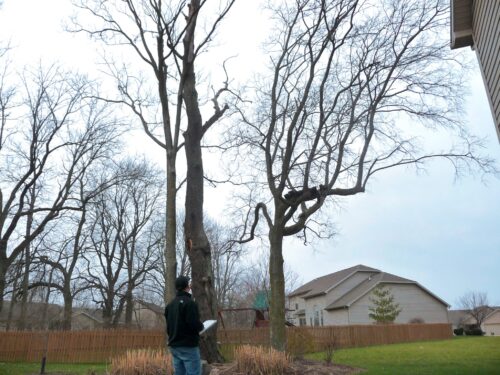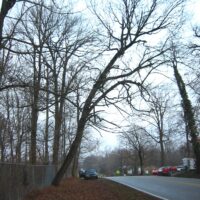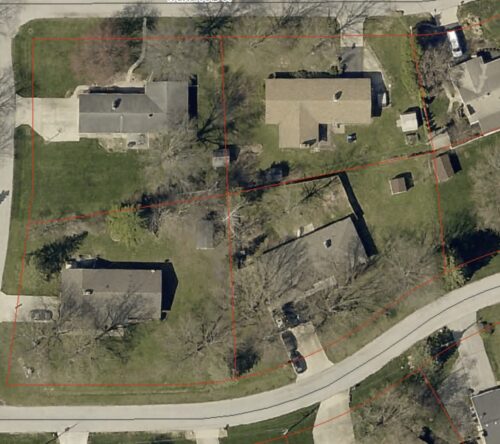 Purdue University - Extension - Forestry and Natural Resources
Purdue University - Extension - Forestry and Natural Resources
Got Nature? Blog
Purdue Landscape Report: I hear this complaint or issue more frequently, “what can I do about the neighbor’s tree?” or “my neighbor just butchered my tree!”. Often, we see issues with a neighboring tree that may threaten safety or appears to be an elevated risk. For example, from the view of your window, you see your neighbor’s tree dropping dead branches all over your driveway. Or, you can’t see a favorable view at all because of that tree or unruly hedge. Or you are certain that the neighbor’s tree will eventually fall onto your garage.
Before you take any action, establish ownership of the tree, and find out if you have rights to work on the offending vegetation. Otherwise, it can land you into a contentious legal situation.
Some questions to consider include:
When tree limbs or even the trunk of the tree crosses property line, are you within your rights to prune or remove it?
Boundary laws vary with every state. Often the boundary lines are uncertain or assumed based on local information. However, in contentious situations that may result in major modifications to a tree, it is advised to get a survey to establish exactly who owns the tree.
Rights are determined by who owns the tree. Check with your town, city, county and state municipalities for regulations about trees and property lines. The rights and responsibility for care and maintenance of trees are assigned to its owner, and ownership is determined by the location of the tree’s trunk. If the trunk is located entirely on the neighbor’s land even if its limbs or branches overhang onto your land, the neighbor is the tree’s owner. The neighbor has the sole right to preserve the tree or cut it down. This is true regardless of the neighbor’s motivation or the impact the tree removal would have on your land.

An ISA certified arborist can provide mitigation options that are best for the tree and helpful for the tree owner.
It is always best practice and considerate to first ask your neighbor if you can arrange to have it removed or pruned. They might actually appreciate it.
When tree work is required to remove or prune the tree and neighbor conflict exists, have a qualified tree care provider determine the work specifications on exactly how the tree issue should be mitigated. It is usually a bit more complex than simply stating, “cut limbs back to property line.” The work order must reference the ANSI A300 tree pruning standards to assure the procedures being proposed take into consideration the tree’s future health. Ensure that your tree care provider has a copy of their current liability insurance policy on hand. Check their references as well, not all tree care companies are guaranteed to provide the best results for you or your tree.
The best advice is to hire a tree care professional with the experience, expertise, and equipment to assess and safely prune, remove or otherwise care for your or your neighbors’ trees. Search for a tree care provider in your area. Also, consider hiring an ISA Certified Arborist which can be found here.
According to most attorneys, open-minded communications with the neighbor can result in an acceptable resolution for any situation. This will help to avoid contentious, expensive, time consuming, and unpredictable lawsuits.
Resources
Find Qualified Tree Care, Tree Care Industry Association
Find An Arborist, Trees are Good
Tree Pruning Essentials, video and publication, The Education Store, Purdue Extension Forestry and Natural Resources
Construction and Trees: Guidelines for Protection, The Education Store
Question: Can tree roots cause damage to a home’s foundation?, Got Nature? Blog, Purdue Extension – Forestry and Natural
Lindsey Purcell, Urban Forestry Specialist
Purdue University, Department of Forestry and Natural Resources

Recent Posts
- Report Spotted Lanternfly – Purdue Landscape Report
Posted: April 10, 2024 in Alert, Forestry, Invasive Insects, Plants, Wildlife, Woodlands - Declining Pines of the White Variety – Purdue Landscape Report
Posted: in Alert, Disease, Forestry, Plants, Wildlife, Woodlands - Are you seeing nests of our state endangered swan? – Wild Bulletin
Posted: April 9, 2024 in Alert, Forestry, How To, Wildlife - Cicadas in Spring! – Purdue Landscape Report
Posted: in Forestry, Plants, Safety, Wildlife - New Deer Impact Toolbox
Posted: April 7, 2024 in Forestry, Land Use, Plants, Publication, Safety, Wildlife, Woodlands - 2024-25 Fishing Guide now available – Wild Bulletin
Posted: April 4, 2024 in Alert, Aquaculture/Fish, Aquatic/Aquaculture Resources, How To, Ponds, Wildlife - Help Research Chronic Wasting Disease – Wild Bulletin
Posted: April 3, 2024 in Disease, Forestry, How To, Safety, Wildlife, Woodlands - Indiana Reptiles and Amphibians – IFWOA Webinar
Posted: April 1, 2024 in Forestry, How To, Webinar, Wildlife, Woodlands - Birding through the Seasons – IFWOA Webinar
Posted: in Forestry, How To, Webinar, Wildlife, Woodlands - Look Out for Invasive Carp in Your Bait Bucket – Wild Bulletin
Posted: March 31, 2024 in Alert, Aquaculture/Fish, Aquatic/Aquaculture Resources, Invasive Animal Species, Wildlife
Archives
Categories
- Alert
- Aquaculture/Fish
- Aquatic/Aquaculture Resources
- Ask the Expert
- Christmas Trees
- Community Development
- Disease
- Drought
- Forestry
- Forests and Street Trees
- Gardening
- Got Nature for Kids
- Great Lakes
- How To
- Invasive Animal Species
- Invasive Insects
- Invasive Plant Species
- Land Use
- Natural Resource Planning
- Nature of Teaching
- Plants
- Podcasts
- Ponds
- Publication
- Safety
- Timber Marketing
- Uncategorized
- Urban Forestry
- Webinar
- Wildlife
- Wood Products/Manufacturing
- Woodland Management Moment
- Woodlands

